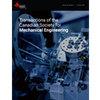THE EFFECT OF PIERCING AND DRILLING PROCESSES ON BURR FORMATION AND DELAMINATION OF AGED CARBON AND ARAMID FIBER REINFORCED POLYMER COMPOSITES
IF 1
4区 工程技术
Q4 ENGINEERING, MECHANICAL
Transactions of The Canadian Society for Mechanical Engineering
Pub Date : 2023-02-08
DOI:10.1139/tcsme-2022-0150
引用次数: 0
Abstract
There are two major problems with Fiber Reinforced Polymer (FRP) composites during their machining that need to be addressed. The first concern is the delamination and formation of burrs at machined edges, and the second is the effects of aging leading to mechanical deterioration. In this study, Carbon Fiber Reinforced Polymer (CFRP) and Aramid Fiber Reinforced Polymer (AFRP) composites are manufactured by vacuum infusion method and aged for two years under natural environmental conditions. Piercing with three different clearances (1%, 5% and 10% of sheet thickness) and speed of 4m.s-1 are performed. Additionally, conventional drilling is carried out with a feed rate of 0.2 m/min, respectively. The highest delamination factor difference between piercing and drilling processes were calculated as 7.3% and 13.9% for CFRP and AFRP, respectively. The highest burr amounts for AFRP and CFRP composites are obtained as 91.5% and 39% at 10% clearance for piercing process whereas 123% and 32.1% for drilling process, respectively. Compared to drilling, piercing generates less burr formation except for CFRP composites in case of 10% clearance and more precise hole production. It is understood that piercing results significantly improves when smaller clearances up to 5% of the sheet thickness are utilized.穿孔和钻孔工艺对老化碳纤维和芳纶增强聚合物复合材料毛刺形成和分层的影响
纤维增强聚合物(FRP)复合材料在加工过程中有两个主要问题需要解决。第一个问题是机械加工边缘的分层和毛刺形成,第二个问题是导致机械退化的老化影响。在本研究中,采用真空灌注法制造了碳纤维增强聚合物(CFRP)和芳纶纤维加强聚合物(AFRP)复合材料,并在自然环境条件下老化两年。采用三种不同间隙(板材厚度的1%、5%和10%)和4m.s-1的速度进行穿孔。此外,常规钻孔分别以0.2m/min的进给速率进行。CFRP和AFRP的穿孔和钻孔过程之间的最高分层因子差异分别为7.3%和13.9%。AFRP和CFRP复合材料的最高毛刺量分别为91.5%和39%,在穿孔过程中为10%的间隙,而在钻孔过程中为123%和32.1%。与钻孔相比,在间隙为10%的情况下,除了CFRP复合材料外,穿孔产生的毛刺更少,并且产生的孔更精确。可以理解,当使用高达片材厚度5%的较小间隙时,穿孔结果显著改善。
本文章由计算机程序翻译,如有差异,请以英文原文为准。
求助全文
约1分钟内获得全文
求助全文
来源期刊
CiteScore
2.30
自引率
0.00%
发文量
53
审稿时长
5 months
期刊介绍:
Published since 1972, Transactions of the Canadian Society for Mechanical Engineering is a quarterly journal that publishes comprehensive research articles and notes in the broad field of mechanical engineering. New advances in energy systems, biomechanics, engineering analysis and design, environmental engineering, materials technology, advanced manufacturing, mechatronics, MEMS, nanotechnology, thermo-fluids engineering, and transportation systems are featured.

 求助内容:
求助内容: 应助结果提醒方式:
应助结果提醒方式:


